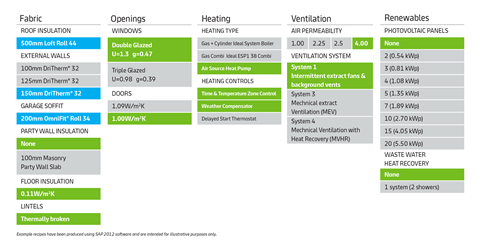As we approach the 2025 Future Homes Standard, guidance around home design is tightening. Here, Matthew Prowse, Specification and Housing Director at Knauf Insulation explores how wider wall cavities can help architects retain essential flexibility in their designs while futureproofing for the stricter regulations that lie ahead

Last year’s updates to Approved Document L tightened requirements for the thermal performance of new homes and the introduction of the Building Regulations England Part L (BREL) report now requires photo evidence of thermal continuity and quality insulation. More recently, the Building Safety Act has introduced a new system of Gateways to act as ‘checkpoints’ for the Health and Safety Executive to assess Building Regulation compliance.
With regulations evolving and design under increasing scrutiny, architects need solutions they can rely on to meet requirements now and in the future. But that ‘futureproofing’ mustn’t come at the expense of design flexibility. So, how can wider cavities help you balance the two?
As-built thermal performance
Regulations around energy efficiency are stricter than ever, so understandably, ensuring thermal performance is a high priority. Considering the lambda value of insulation is a good place to start, as it gives an indication of thermal performance. However, achieving that same performance once built also relies on correct installation.
When insulation is poorly installed, air gaps can form, compromising thermal performance. Unfortunately, some materials are more prone to this than others. For example, rigid board insulation won’t sit flush against a cavity wall unless perfectly uniform and flat. Boards must also be cut to size and taped with precision, allowing further opportunity for gaps to form. A study into thermal looping in cavity walls, partially filled with insulation boards, showed that a 6mm gap is enough to cause an increase in heat transfer of 158%. Whilst 100mm of rigid board insulation might fit the bill on paper, it won’t necessarily deliver that same performance as-built.
Designing with 100mm cavities limits you to using certain types of insulation but 150mm cavities gives you more options. For example, it allows you to use mineral wool insulation, which is flexible and adapts to minor imperfections in the substrate, fully filling the cavity. Where two slabs or rolls meet, the ends also ‘knit’ together, further minimising air gaps and maximising thermal performance. In other words, a cavity filled with 150mm of mineral wool insulation is more likely to deliver the performance specified in your design.

Safety and sustainability
Fire safety and sustainability are also receiving more and more attention when it comes to home design. Approved Document B tightened the guidance on using combustible materials in 2022. London Plan guidance now states that major development proposals must be submitted with a Fire Statement confirming that no combustible materials will be incorporated in the development’s external walls. There is a clear direction of travel towards prioritising non-combustibility, and designing with wider cavities gives you the freedom to choose non-combustible products like Knauf Insulation’s DriTherm® Cavity Slab 32, which has the best possible Euroclass A1 reaction to fire classification.
The Future Homes Standard aims to further reduce the operational carbon produced by new homes and it’s only a matter of time until regulations also address embodied carbon. Embodied carbon is the total greenhouse gas emissions released in producing a build asset, such as from raw materials and transportation; industry bodies are already supporting a proposed ‘Part Z’ Building Regulation to measure and assess it. Again, 150mm cavities give you the flexibility to meet energy efficiency requirements, with products like glass mineral wool, which has the lowest levels of embodied carbon of any mainstream insulation material.
Considering all these factors, it’s no surprise that wider cavities are becoming the new normal. In a recent survey of housebuilders, 41% of participants had already switched to 150mm for new homes and just over a quarter were actively considering it.
Let’s look at an example of how it can be done…
Example whole-house recipe
The energy efficiency of a home is measured as a whole, so increasing the thermal performance of your fabric gives you the flexibility to choose other elements, such as photovoltaic panels or heat sources, based on the individual priorities of your project.
For example, a four-bedroom, detached house could feature 150mm DriTherm® Cavity Slab 32 insulation in the walls, alongside 500mm of Loft Roll 44 insulation in the loft. With the right fabric, the design could also feature double-glazed windows, an air source heat pump, and heating controls that use time and temperature zone control. (See table below for full example recipe.)

Designing with wider cavities keeps your options open as regulations continue to change. With 150mm cavities, you can choose the best materials and wider whole-house ‘recipe’ to suit the needs of your project. It’s about finding your best route to compliance today and being ready to adapt for tomorrow.
For more example recipes, download our free Part L Guide at Knauf Insulation’s Housebuilders Hub.














